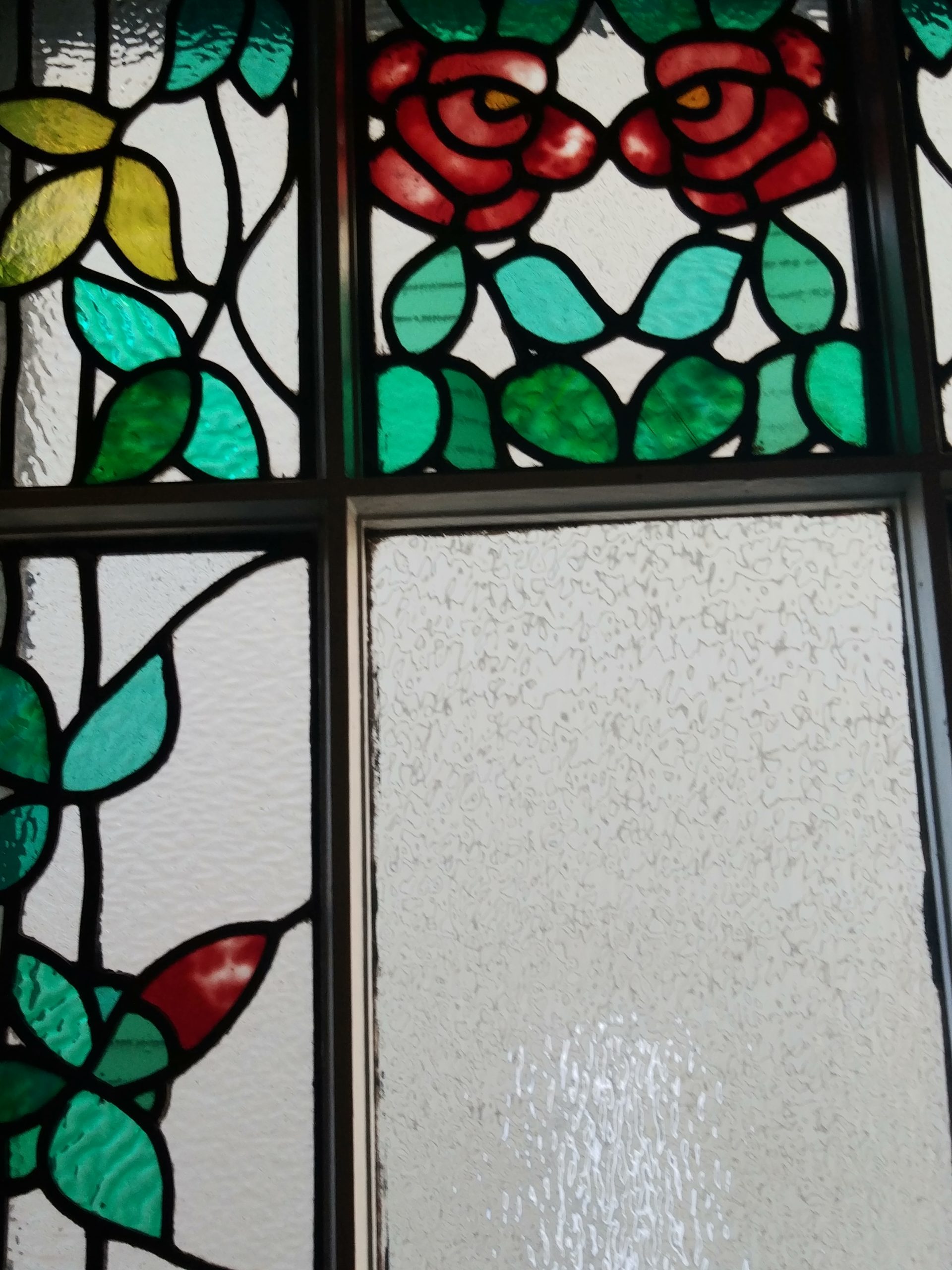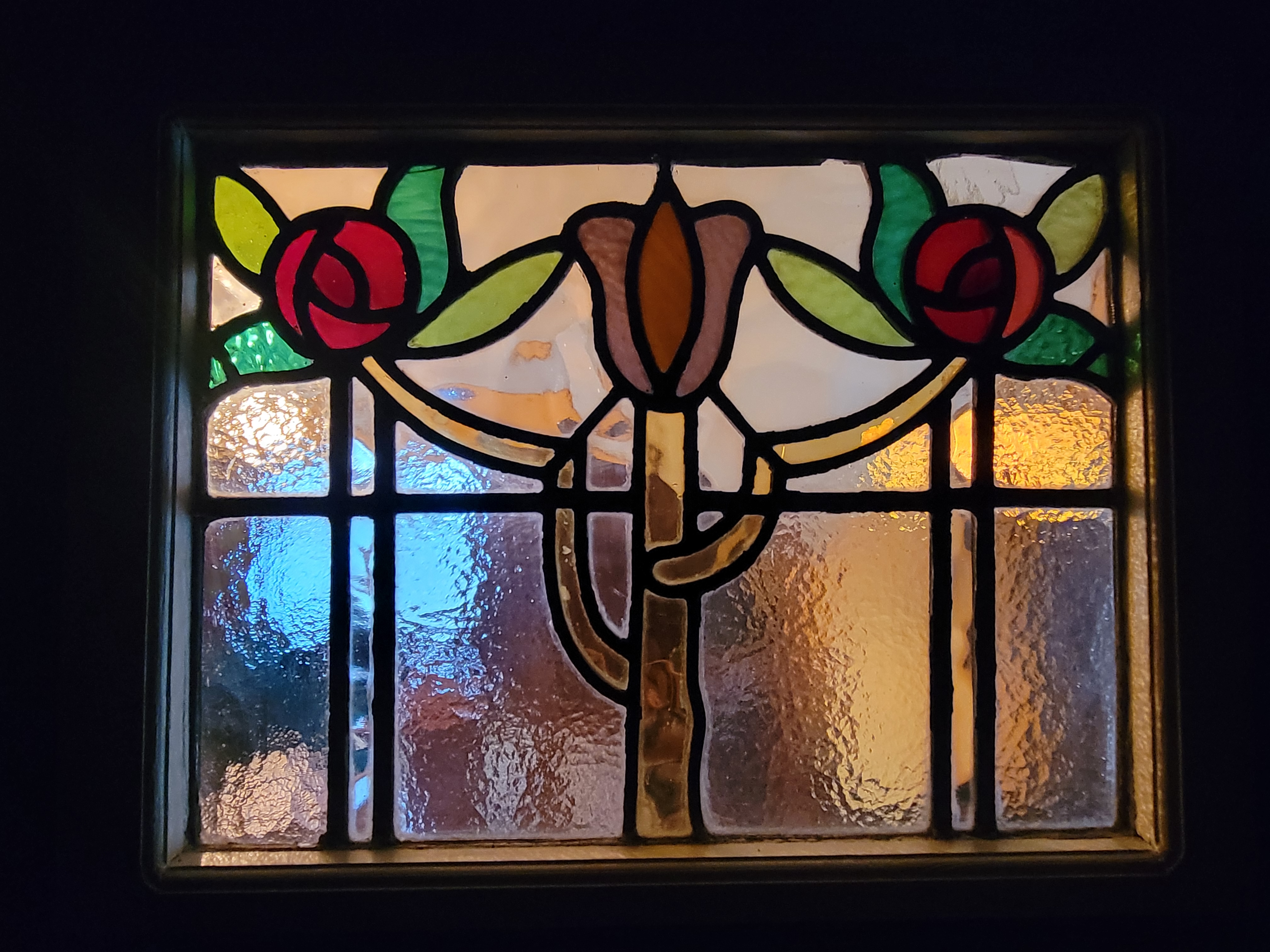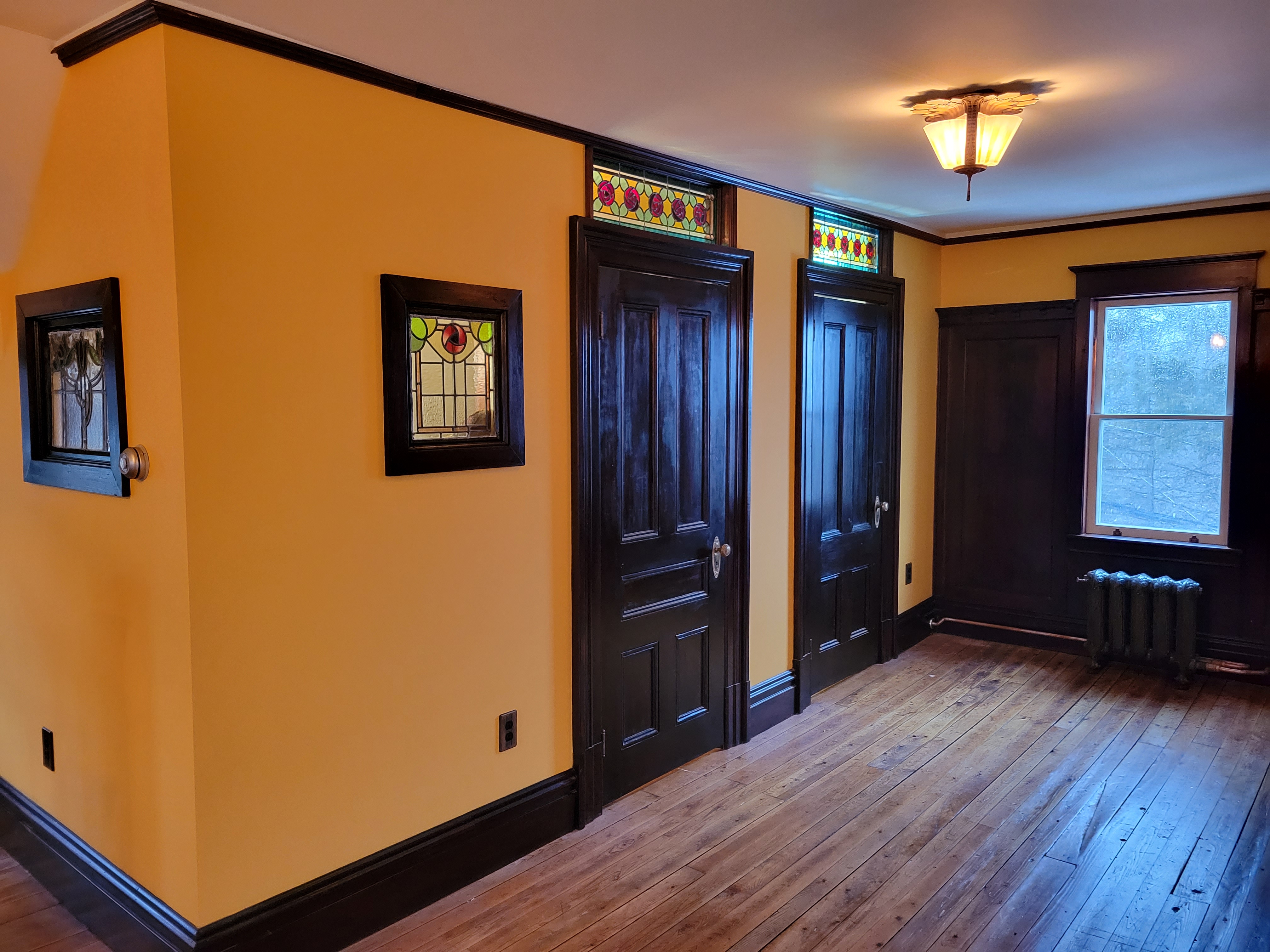Our home has nice art glass – stained and leaded beveled glass – and I want to share what we have in the house and what we added when restoring our home. At the end of this blog are pics from some spectacular sample in Saint Awesome. I cannot strongly encourage you enough to snoop around the city especially in the evening (from public sidewalks of course) to see some of the fabulous examples that still exist.
Our 1910 home was one of five on Alexandra St. built with the same floor plan. All homes were finished differently to give them a cohesive but unique look. Our home is finished with a faux tudor aesthetic. To achieve this, our windows, for the most part, are not stained glass but instead the character defining elements include a tudor consistency of blocked pieces of glass. I ensured that the curtains are uniform and do not block the important window features at the top (I also tried to see from historic pics of our home if I could make out what the curtain style originally was). Even the front door picks up this design in the windows which has beautiful beveled glass.


Within our home, our dining room and attic have a continued faux tudor look. Our neighbours in the other related homes, have more stained glass than our home because their finishings are different.
At the top of our landing (noted in pics below), which is reached by a staircase from the foyer and a staircase from the kitchen, is a stained glass window with beautiful rose details. This resonates with us for two reasons: Theodore Estabrooks, President of the Red Rose Tea Company, was a founding member of the Fenton Land and Building Company that built our home and we associate the red rose with Estabrooks (we drink Red Rose tea daily); and secondly we bought this home just a year and a half after a trip to Glasgow where we focused on the works around the city of Charles Rennie Mackintosh which incorporate this beautiful mackintosh rose.



Stained glass, as advertized by Murray & Gregory, Limited – the company that supplied both the lumber and the glass for our home, served a few purposes. Not only was it beautiful but it provided privacy, let in light, removed the need for curtains saving money over time, and was economical to purchase because the price difference was minimal in comparison to regular glass.


In our main bathroom, we had privacy glass. One panel was not original. We decided to have a design from the 1913 Murray & Gregory catalogue created incorporating the existing privacy glass. Note the mackintosh rose.
Image below from the 1913 catalogue:

Final installation below:![]()

![]() In our attic, where our second full bathroom was placed (the half bath for day staff has simple and lovely privacy glass), we used antique stained glass windows that have the mackintosh rose along with a tudor feel that we find in the external windows of our home. These windows let in light and maintain privacy.
In our attic, where our second full bathroom was placed (the half bath for day staff has simple and lovely privacy glass), we used antique stained glass windows that have the mackintosh rose along with a tudor feel that we find in the external windows of our home. These windows let in light and maintain privacy.


We also had transom windows created and installed above the attic bathroom and storage rooms with the mackintosh roses and a tudor vibe in the design.



We have a room on the second floor that can act as den or bedroom. When the door is closed no natural light goes down the hall. Consequently, I swapped doors from my kitchen to the back cold storage area and put it in this room because there was glass in this window – it was old and wavy but not beveled. However, if changing in this room, there was not a lot of privacy. Our stained glass guru took a Charles Rennie Mackintosh design and inserted red jewels for the rosebuds which was a brilliant idea – when in doubt, jewel it out!

Privacy glass from the Algonquin Hotel was used. Now we have privacy and light still goes into the hallway.
Before:

The process:

After:


Our kitchen has two large sashed windows. There were cracks in the glass of both upper sashes. The kitchen is the coldest room in the house so I knew the glass needed remediation. It’s also odd how large these windows are and where they are positioned. When looking at the drawing by Fenton’s drafter Gillies, there were comments that the builders should adjust window locations to suit the building. Our large windows make the wall not very useful to place furniture against and the view is of our neighbours’ driveway – I am fairly certain my neighbours would like to come and go without us watching. I disliked the idea that people could see right into our kitchen although the natural light is delightful. I did not want curtains because our boy has a knack of getting ketchup in surprising and hard to clean places (like on our ceiling). We also felt like we needed some more colour (see the Old House Guy for information on the historical use of colour in a kitchen).

We decided to put in faux tudor windows that pick up the colours of the remaining battleship linoleum in the back porch and side entrance – yellow, red, black, and green (and a little blue for good measure).


I saw this image online and knew it was a great inspiration for us! My husband did not want any mackintosh roses because he does not want the kitchen windows to compete with the rest of the home as the kitchen was intended to be utilitarian. We love this design because it is clearly Dutch deco ca. 1930s – we lived in The Netherlands for 3 years, and I could feel the Mondriaan vibe as soon as I saw the pic. It has a tudor look and it has the colours of our linoleum.

Here is the sketch before we began work on the project. You can tell I asked for jewels!

When picking out glass we chose the clear section to be glittery beauty and I wondered it is was too much until I saw Casa Fenoglio Lafleur built in 1902 by Pietro Fenoglio in Turin, Italy.

When the light hits the glass it is incredible. And this window was created close to the same time as our home so there is historical congruence.

This is the before:

This is during:


This is after:

We did have this fab Mackintosh inspired lamp made that has a sort of waterfall of jewels. The top is made with a Polish dish from the 1920s made by the Irena factory apparently. Not a stained glass window but so beautiful it is worth sharing.

I have no idea how and when, but I plan to use these historic stained glass windows in our home.



Here are some pics of what I love in other Saint Awesome homes – this is a SMALL sampling. Saint John has so much historical beauty on display. My husband commented that Charlottetown does not have the volume of stained glass that we seem to have. Perhaps the numerous examples of beautiful art glass in this city is a Saint John phenomenon and a testament to the building companies that thrived here.







I know this is one of the worst pics ever. I would LOVE to be invited into the home at the corner of Hazen and Garden that has a stained glass with a ship in it surrounded by jewels. I just cannot even.


The windows and short transoms are on interior walls?
yes